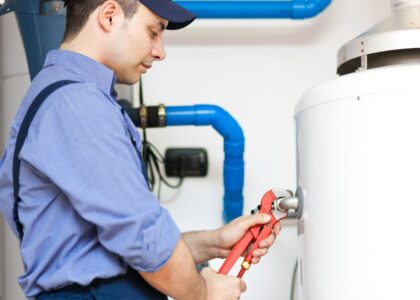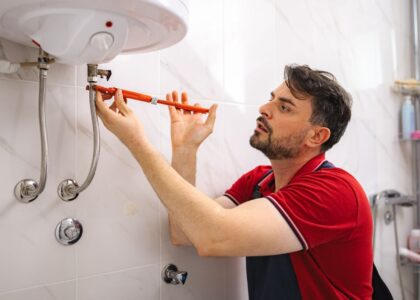Introduction
Choosing between a tank and tankless water heater is a big decision—and one that directly impacts your repair needs down the road. In this post, we compare both types, explore pros and cons, common repair issues, and how to decide which is more suitable for your home.
What Are Tank and Tankless Water Heaters?
Tank Water Heaters
These are traditional systems that store and continuously heat a reservoir of water (commonly 30–80 gallons). They maintain temperature so that hot water is ready on demand.
Tankless (On-Demand) Water Heaters
These units only heat water when a faucet or appliance is turned on—no standby storage. They are often more energy efficient, but they require more complex components.
Pros & Cons: Tank vs Tankless
| Feature | Tank Water Heater | Tankless Water Heater |
|---|---|---|
| Upfront cost | Generally lower | Higher, due to advanced tech |
| Energy use | Some energy loss (standby heating) | More efficient; less standby loss |
| Flow and capacity | Limited by tank size | Depends on flow capacity |
| Repair complexity | Simpler components | More advanced parts (heat exchangers, sensors) |
| Longevity | Typically 8–12 years | Often 15–20 years |
| Initial plumbing expense | Simpler install | May require upgraded gas line or venting |
Common Repair Issues by Type
Tank Water Heaters
- Sediment buildup
- Heating element failure
- Leaks, seals, or tank corrosion
- Thermostat failure
- Faulty pressure relief valve
Tankless Units
- Scale buildup inside the system
- Faulty sensors or microprocessors
- Flow sensor problems
- Heat exchanger damage
- Ignition or flame failure (gas models)
Life Cycle Repairs: What to Expect in Years 1–5, 5–10, 10+
Years 1–5
- Troubleshooting ignition (gas) or heating elements (electric)
- Minor leaks, valve replacements
- Regular maintenance (flushing, filter cleaning in tankless)
Years 5–10
- More frequent component replacements (thermostats, igniters, seals)
- Tank corrosion, early leaks
- Sensor failures in tankless units
After Year 10
- Major corrosion or tank breach
- Heat exchanger failure
- Diminished capacity; increasing repair costs
- At this stage, Water Heater Repair may approach or exceed replacement cost
How Repair Works for Both Systems
Whether tank or tankless, the process for repair generally follows:
- Safety shutdown
- Inspection and diagnostics
- Explanation and parts ordering or onsite repair
- Repair or component replacement
- Testing and validation
- Cleanup and maintenance advice
The exact parts and complexity depend on the type of heater. In all cases, a professional with experience handling both systems is ideal.
If you operate in Long Beach or surrounding regions, the service team at Water Heater Repair can handle either type. See more on repairs at https://speedyplumberslongbeachca.com/water-heater-repair/ and reach out at https://speedyplumberslongbeachca.com/contact-us/.
Sizing & Compatibility: What You Must Get Right
Choosing the right capacity and compatibility helps avoid repair issues later:
- Tank units: get a tank size that matches your household’s peak usage. Too small → constant running; too large → wasted energy.
- Tankless systems: choose a model with sufficient flow rate (GPM) and temperature rise. If your demand exceeds the unit’s capacity, repairs and strain will follow.
- Assess compatibility with your home’s electrical supply (for electric units) or gas line sizing and venting (for gas units).
Maintenance Tips That Aid Repair Prevention
Whether tank or tankless, maintenance is key:
- Tank: flush annually, replace anode rod, test the pressure relief valve
- Tankless: flush with descaling solution (especially in hard water areas), clean filters, check sensors
- Monitor system alerts or error codes (common in modern tankless units)
- Inspect external valves, pipes, and connections yearly
Regular maintenance can reduce repair frequency and prolong lifespan.
When Repair Makes Sense vs Replacement
You’ll likely opt for repair when:
- The problem is isolated (one heating element, one valve)
- The existing system is relatively young
- Repair cost is a fraction of replacement
- Performance is otherwise satisfactory
Consider replacement if:
- You face multiple or recurring issues
- The unit is reaching or past its expected life
- Efficiency is severely compromised
- Upgrading to a better model offers long-term savings
Repair is often the first course—and for many years, it’s the wisest.
Summing Up
Choosing between tank and tankless heaters affects both daily comfort and your repair experience. Knowing the common issues, repair procedures, and maintenance needs helps you make educated decisions. Whether you’re repairing or upgrading, always get professional help.
Want dependable water heater service in Long Beach? Visit our Water Heater Repair page: https://speedyplumberslongbeachca.com/water-heater-repair/
To schedule assessment or repair, see our contact page: https://speedyplumberslongbeachca.com/contact-us/





